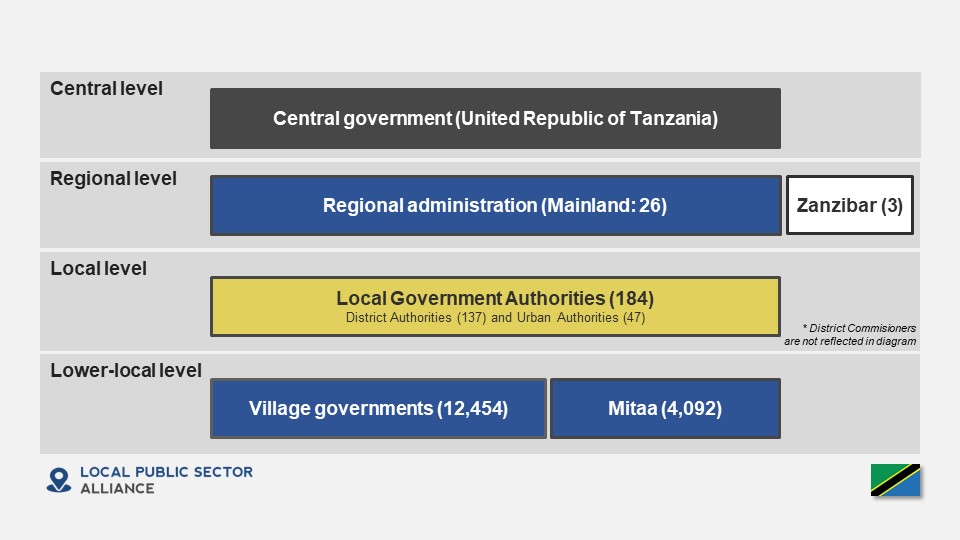
The United Republic of Tanzania is a union of two sovereign states: the Republic of Tanganyika and the People’s Republic of Zanzibar. A treaty of Union was concluded on April 22, 1964, resulting in one United Republic. In mainland Tanzania (formerly Tanganyika), decentralization has ebbed and flowed through several phases, intertwined with political upheavals. The first phase (1967-72) involved a process of re-centralization of power in which local governments were abolished and replaced with centrally coordinated planning via deconcentrated administration. The second phase (during the 1980s) saw the re-establishment of elected local government authorities after the rapid decline in essential services under the earlier phase. The third phase (from 1996 onwards) has been to promote the autonomy of local governments to enhance their effectiveness under the Decentralization by Devolution (D-by-D) principle. Despite the government’s formal policy in support of devolution over the past quarter century, local government authorities in Tanzania retain many centralized elements in their institutional setup (e.g., limited administrative autonomy and a reliance on earmarked grant resources from the center).
Subnational government structure
At the central government level, Tanzania is governed by two governments: (i) the Government of the United Republic, which exercises powers over all union matters as well as non-union matters within mainland Tanzania; and (ii) the Revolutionary Government of Zanzibar which is an autonomous government that exercises powers over non-union matters in Zanzibar. Mainland Tanzania is divided into 26 administrative regions. These regions are deconcentrated administrations playing oversight, advisory and coordinating roles in service delivery undertaken by Local Government Authorities (LGAs). There are 184 LGAs in mainland Tanzania out of which 137 are rural district authorities and 47 are urban authorities. Urban LGAs consist of 6 city councils, 20 municipal councils and 21 town councils. Below the LGAs are village governments (in rural areas) and mitaa (urban neighborhoods). Below the villages are sub-village units called vitongoji.
Nature of subnational governance institutions
Subnational governance in Mainland Tanzania is characterized by a mix of non-devolved and hybrid subnational governance institutions. Regions are deconcentrated administrative entities that lack their own elected political leadership, are managed by central government staff, and are funded via regional votes in the central government budget. Although LGAs are legally defined as corporate bodies, in practice, they are hybrid entities with both devolved and non-devolved features. While LGAs have their own elected political leadership, formally employ their own officers and staff, and approve and manage their own budgets, in practice LGAs lack autonomy in several areas. For instance, they do not appoint their own Executive Director; are not able to determine their own organizational structures; and have limited authority over their officers and staff. In addition, the de jure and de facto control of elected local leaders over their own budgets is severely constrained by the higher-level government. Village governments do not meet the definitional requirements of local governments because they are not de facto corporate bodies (due to the fact that they do not select or employ their own officers) which severely limits their authority in practice.
Functional assignments
Local government functions are assigned in the Local Government (District and Urban Authorities) Acts of 1982, while intergovernmental relations are structured under the Regional Administration Act, 1997 (as amended). LGAs formally provide and coordinate provision of agricultural, trade, commerce and industry services as well as basic social services including pre-primary, primary and secondary education, primary health, and agricultural extension services. Despite LGA’s extensive formal role in public service delivery provision, in practice, central government ministries are extensively involved in local-level planning, decision-making, human resource management, and service delivery implementation. In addition, several functional responsibilities have been moved away from LGAs over recent years. These include the provision of water and sanitation services which are now under the authority of the Rural Water Supply and Sanitation Agency (under the Ministry of Water) as well as road transportation, which is now under the Tanzania Rural and Urban Road Agency.
LoGICA Assessment
LoGICA Intergovernmental Profile: Tanzania 2023 (Excel)
Selected resources
Tanzania Country Profile (World Observatory on Subnational Governance and Investment, OECD/UCLG)
The Local Government System in Tanzania (Commonwealth Local Government Forum)
Local government country profile: Tanzania (UN Women)
Back to Local Public Sector Alliance Intergovernmental Profiles – Country Page
Last updated: December 29, 2023


